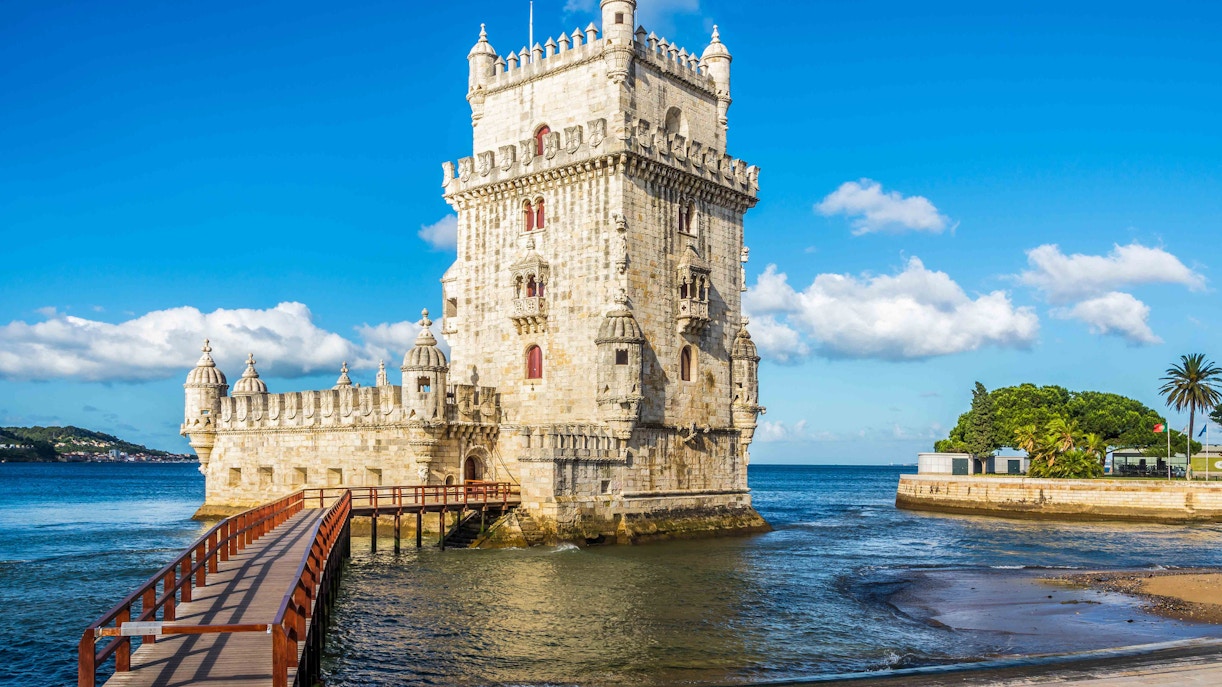- Pena Palace
- Quinta da Regaleira
- Monastery of Jerónimos
- Oceanario Lisboa
- São Jorge Castle
- SL Benfica Stadium & Museum Tours
- Royal Treasure Museum
- Lisbon To Sintra Tours
- Fado Intangible Cultural Heritage
- National Coach Museum in Lisbon
- Navy Planetarium
- Maritime Museum
- Ajuda National Palace
- Mafra National Palace
Discover the Rich History of the Belem Tower
What is Belem Tower?

Built in the 16th century, the Belem Tower was built to defend Lisbon from enemy ships. Around 1515, architect Francisco de Arruda designed the iconic monument and it served the purpose of being a fort that protected Lisbon from incoming raids along the Tagus River. It also marked the beginning of voyages for sailors.
Today, the Belem Tower is one of the most famous tourist destinations in the world, and for a good reason. Constructed in a Manuelino style, the tower has a unique design with a modern and heavily armed bastion, protruding over the river. Years later, the tower was transformed into a lighthouse and then a customs center.
Where is the Belem Tower Located?

Address: Av. Brasília, 1400-038 Lisboa, Portugal | Find on maps
The iconic Belem Tower is located in Lisbon, Portugal in the south of Europe. This structure was built to serve both as a gateway to the city of Lisbon as well as a defense against possible invasions.
History of The Belem Tower

The Origin
The Belem Tower was built in the 16th century, by architect Francisco de Arruda, a fort that was built to protect Lisbon from the incoming raids along the River Tagus. This also marked the beginning of voyages for sailors and the last sight of land. The tower was used longer as a state prison than a defense port. Over the years and with evolution happening, the tower lost its function to defend and was used as a customs port in 1655, a telegraph station in 1810, and a lighthouse in 1865.

The Architect
Built by a military architect, Francisco de Arruda, the Belem Tower is considered to be one of the best examples of the Manuelino style architecture, during the time. It also includes distinctive Moorish features such as ornately decorated turrets. e also worked on several other notable projects, including the fortifications of Tangier and the Palace of Sintra.

Purpose of Belem Tower
The Belem Tower served as a point of embarkation and disembarkation for Portuguese explorers and was a ceremonial gateway to Lisbon. Belem Tower also provided a strategic point to defend the city. Suggestions were put forward to improve and strengthen the tower in 1571. Francisco de Holanda recommended it was necessary to improve the coastal defenses to protect the kingdom.

Construction of Belém Tower
The construction of Belém Tower began in 1514 under the direction of Francisco de Arruda. The tower was built on a small island in the Tagus River, which was later connected to the mainland as the river shifted its course. The tower is approximately 30 meters tall and is divided into five levels, including a terrace at the top. The tower was built in the Manueline style, which was popular during the reign of King Manuel I of Portugal.

The architect who designed and oversaw the construction of the Belém Tower was Francisco de Arruda, a Portuguese architect who was active during the reign of King Manuel I of Portugal. Arruda was a highly regarded architect and engineer who was known for his innovative and ornate style. He also worked on other notable buildings in Portugal, including the Jerónimos Monastery, which is located nearby the Belém Tower.
Belem Tower Architecture

The Belem Tower is a beautiful example of modern Renaissance architecture. It has a historic feel to it and is a testimony of the transitional nature of military architecture that features the defense of the Middle Ages.
The Belem Tower is known to be one of the major works of the Manueline style, due to its typical motifs and elaborate warheads. The Belem Tower is divided into two parts, the bastion, shaped like an irregular hexagon, and the tower of four floors, which stands on the north face of the bastion. The whole tower is designed with twisted cords carved in stone and forms a knot on the north façade of the building.
Frequently Asked Questions About Belem Tower History
A. The Belem Tower was built between 1514 and 1520 and was classified as a World Heritage Site in 1983 by UNESCO.
A. The Belem Tower is famous as it celebrates the expedition that was led by navigator Vasco da Gama, who had established a maritime trade route from Portugal to India.
A. The Belem Tower is located on the northern bank of the Tagus River in the city of Lisbon, Portugal, south of Europe.
A. The Belem Tower was designed by the famous military architect Francisco de Arruda.
A. The Belem Tower is known for being the best example of the Manueline style of architecture that was famous in early 16th century Portugal.
A. The Belem Tower tickets start from 6 euros. If you wish to explore the Jeronimos Monastery along with the tower, go for the combination ticket for 12 euros.
A. Yes, there are guided tours available, led by a local historian, you can explore the Belem Tower and get an insight into Portugal’s Age of Discovery.
A. Listed as a UNESCO World Heritage Site, the Belem Tower offers a story of the Portuguese Age of Discovery. Visit the attraction to check out the spiral staircase, and the rooftop terrace for great views and admire the architectural details and rooms.
